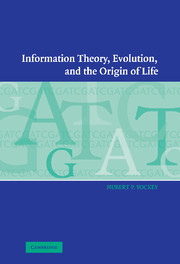Book contents
- Frontmatter
- Contents
- Preface
- 1 The genetic information system
- 2 James Watson, Francis Crick, George Gamow, and the genetic code
- 3 The Central Dogma of molecular biology
- 4 The measure of the information content in the genetic message
- 5 Communication of information from the genome to the proteome
- 6 The information content or complexity of protein families
- 7 Evolution of the genetic code and its modern characteristics
- 8 Haeckel's Urschleim and the role of the Central Dogma in the origin of life
- 9 Philosophical approaches to the origin of life
- 10 The error catastrophe and the hypercycles of Eigen and Schuster
- 11 Randomness, complexity, the unknowable, and the impossible
- 12 Does evolution need an intelligent designer?
- 13 Epilogue
- Mathematical appendix
- Glossary
- References
- Index
7 - Evolution of the genetic code and its modern characteristics
Published online by Cambridge University Press: 15 August 2009
- Frontmatter
- Contents
- Preface
- 1 The genetic information system
- 2 James Watson, Francis Crick, George Gamow, and the genetic code
- 3 The Central Dogma of molecular biology
- 4 The measure of the information content in the genetic message
- 5 Communication of information from the genome to the proteome
- 6 The information content or complexity of protein families
- 7 Evolution of the genetic code and its modern characteristics
- 8 Haeckel's Urschleim and the role of the Central Dogma in the origin of life
- 9 Philosophical approaches to the origin of life
- 10 The error catastrophe and the hypercycles of Eigen and Schuster
- 11 Randomness, complexity, the unknowable, and the impossible
- 12 Does evolution need an intelligent designer?
- 13 Epilogue
- Mathematical appendix
- Glossary
- References
- Index
Summary
I believe no one will be surprised that a large number of the points considered demand a far fuller, more rigorous, and more comprehensive treatment. It seems impossible that full justice should be done to the subject in this way, until there is built up a tradition of mathematical work devoted to biological problems, comparable to the researches upon which a mathematical physicist can draw in the resolution of special difficulties.
Sir Ronald Aylmer Fisher, (1958)Early speculations on the evolution of the genetic code
The difficulty of determining the origin of the genetic code
Many papers have been published with titles indicating that their subject is the origin of the genetic code, but actually the content deals only with its evolution. Authors assume that the origin of the genetic code is inevitable once they have created a scenario that provides the components of an informational molecule.
As I have pointed out:
The calculations presented in this paper show that the origin of a rather accurate genetic code, not necessarily the modern one, is a pons asinorum that must be crossed to pass over the abyss that separates crystallography, high polymer chemistry and physics from biology.
(Yockey, 1981, 1992)The paradox is seldom mentioned that enzymes are required to define or generate the reaction network, and the network is required to synthesize the enzymes and their component amino acids.
- Type
- Chapter
- Information
- Information Theory, Evolution, and the Origin of Life , pp. 93 - 113Publisher: Cambridge University PressPrint publication year: 2005



